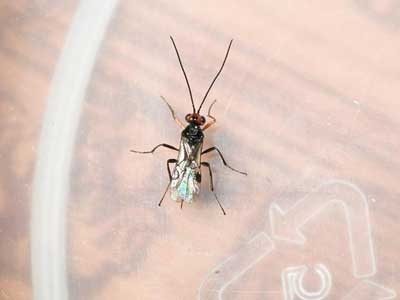More body snatching (continued from last month)
Across the natural world the same question arises again and again: Why would an organism do all it can to ensure its tormentor’s survival rather than fight for its own?
Serving as bodyguard is only one of the protective services provided to parasites by their hosts. A fly that infects bumblebees causes them to burrow into the ground in autumn, right before the fly emerges to form a pupa. In the ground the fly is protected not only from predators but also from the cold of winter.
In Costa Rica, the orb-weaving spider Leucauge argyra will go to extravagant lengths to accommodate the needs of Hymenoepimecis argyraphaga, another freeloading wasp.
The female glues its egg to the host’s body. After the larva emerges, it pokes a few holes in the spider’s abdomen and sucks its blood. When the larva has grown to full size, in a couple of weeks, the spider takes it upon itself to rip down its own web and build a new one of a radically different shape.
Instead of a multistranded net designed for catching flying insects, the new web is merely a few thick cables converging at a central point. Having sucked its host dry, the larva spins its cocoon on a thread hanging from the intersection of the cables. Suspended in the air, the cocoon is nearly impossible for would-be predators to reach.
Parasites
Plasmodium
Parasites can also coax a host to guard them while they’re still living inside it.
Before infecting a human host, Plasmodium, the protozoan that causes malaria, spends the first stages of its life cycle in a mosquito.
The mosquito needs to drink blood to survive. But this behaviour poses a risk to the protozoan, because the mosquito may be crushed by the hand of an annoyed human victim, eliminating the opportunity for Plasmodium to move to the next stage of its life cycle, in the human.
To reduce this risk while it is still developing in the mosquito, Plasmodium makes its host blood-shy, seeking fewer victims each night and giving up faster if it can’t find a gusher of blood.
Once Plasmodium has matured and is ready to enter a human host, it manipulates the mosquito’s behaviour in the opposite direction. Now the mosquito grows thirsty and foolhardy, seeking out more humans each night and biting repeatedly even if it is already full.
If the mosquito dies at the hand of a human, it is no longer of any consequence. Plasmodium has moved on.
While Plasmodium tinkers with the ordinary behaviour of its host to get to the next stage of its life cycle, other parasites wreak far more radical changes—often with fatal results.
Flukes
Killifish, for example, normally stay away from the surface of the water to avoid being picked off by wading birds.
But when they’re infected with flatworms known as flukes, they spend more time near the surface and sometimes roll so that their silvery bellies glint in the light.
Infected killifish are far more likely to be picked off than healthy ones. And it just so happens that the gut of a bird is where the flukes need to go next to mature and reproduce.
The best known mindsucking parasite plays out a similar manipulation on land.
Toxoplasma gondii
Along with other mammal species, rats and mice can be infected with Toxoplasma gondii, a single-celled relative of malaria-causing Plasmodium.
The parasite can form thousands of cysts in the brain of its host. To take the next step in its life cycle, Toxoplasma has to get inside the gut of a cat.
Toxoplasma doesn’t have the means to transport itself from a rat’s brain to a cat’s gut. But if its rat host gets eaten by a cat, the parasite can reproduce.
Scientists have discovered that rats infected with Toxoplasma lose their normal fear of the smell of cats. In fact some infected rats become downright curious about the odour of cat urine, making themselves easy targets for a swipe of a cat’s paw—and thus raising the odds that Toxoplasma will advance through its life cycle.
Mutations and natural selection
How mutations and natural selection could give rise to such creepy powers is a particularly intriguing puzzle for evolutionary biologists.
One useful concept for thinking about it comes from biologist Richard Dawkins, author of the landmark book The Selfish Gene.
(continued next month)
For more information and images, see Tree Fruit Dec 2014




















